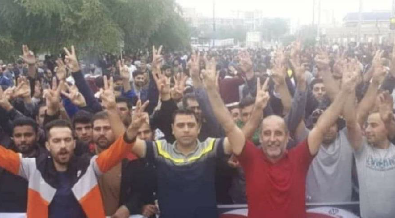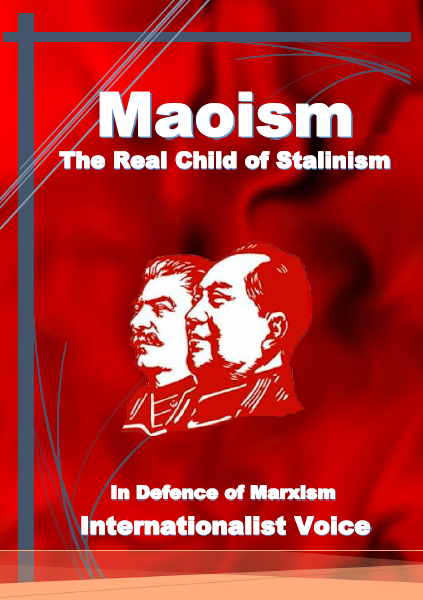Two Movements, Two Perspectives: Intensifying the Class Struggle Is the Only Alternative
The repressive forces of the bourgeoisie tightened their grip and crushed the demonstration to death on 27 December 2009. Dozens of demonstrators were injured or killed and hundreds of demonstrators were jailed. The State Police showed that it has never forgotten how its butchers slaughtered every day in 1981 and, if needed, they will do it again.
Three days later, the theocratic bourgeoisie started the carnival under the slogan “Homage to the Supreme Leader” in all part of the country. Demonstrations were mobilized by the regime in most of the cities to assert its power and to confirm the people’s support for the Islamic bourgeoisie and their loyalty to the Supreme Leader.
Major General Mohammed Ali Jafari, the Head of Pasdaran (the IRGC), declared on 12 January 2010 that:
“Some are looking to change the position of the Supreme Leader to a ceremonial role. What pretext, after the election fraud in the country, was there to attempt to weaken the power the Supreme Leader and transform this role into a ceremonial position, which would dilute the Islamism of the Islamic Republic.”[1]
On the other side, all the tendencies of capital from right to left, from monarchists to the radical phrase part of the left of capital, such as so-called “worker-communists”, confirmed the advance of the people’s movement. Each of them claimed that they are leading the protests of the people and introducing themselves as an alternative to the Islamic Republic.
The People’s Mujahidin declared that they have led the protests and they are the only replacement for the Islamic Republic of Iran. Their leader, Rajavie claimed that:
“The clerical regime doesn’t have any rival and opponent except the People’s Mujahidin of Iran and there will be no replacement except for the National Council of Resistance of Iran.” [2]
What does the people’s movement means for the working class? How can the People’s Movement influence the class struggle? What is the role and task of the internationalists at this stage? Which movement dominates the events in Iran? The fact is that there are two class movement flows in society: the movement for democracy and the movement of the working class.
The Movement for Democracy
The movement for democracy is a movement of the bourgeoisie, an anti-proletariat and counterrevolutionary movement. In an ideal world, this movement would seek to adapt national capital to world capital’s routines, to enforce and modify the capitalist system in Iran, and to give assurance to the accumulation of capital, for both internal and external investors. Capitalism has nothing to offer to the proletariat other than generalized poverty, mass unemployment, unpaid salaries for months, job stress and misery at work: in other words, a real hell for the working class.
In fact, the people’s protests, which were dominated by a nationalist and democratic rationale and spirit, must be considered. However, nationalism is a deadly poison for the class struggle.
The democratic mass media has given the title of “head of the opposition” to a criminal such as Mousavi, who is highly acceptable for the Western World and its policies aimed at securing its interests by pressuring the Iranian government. Meanwhile, this ‘honest’ democratic mass media has not mentioned anything about the dozens of protest actions or strikes of the working class. This will be addressed in the next part. Obviously, it is trying to cover them by highlighting the “Green Movement” of Mousavi.
Before analysing the “Green Movement”, we would like to hear from and define the democratic movement in its own activists’ words. One of the nationalist-leftist tendencies, the “communist” “worker” of Iran describes this movement as a “Rainbow Movement”. Let’s look at two of these statements:
“Greeting to the zealous nation of Iran and brave freedom fighters
…
Green: free elections under the supervision of international authorities
Red: freedom of all political prisoners and the abolition of torture and execution” [3]
After the repression of 27 December 2009, in order to avoid radicalizing the protests, Mousavi changed his approach to save the Islamic bourgeoisie. This policy is well known in Western European, where it is necessary for the leaders of unions or opposition parties to use radical language in order to deflect discontent and then change their minds. Mousavi, in his statement “No. 117”, called for “national unity”. He wrote:
“In recognizing the current crisis, we can find the solution, not in confrontation, but rather in national unity.” [4]
His statement consists of five points which, at least on paper, are within the framework of the Islamic Republic. Following the realization of his statement, he asserts that:
“Our establishment has the power to accomplish this important task, provided it has insight and a respectful and kind view towards the entire nation and its layers.” [5] [our translation]
The last point stresses the importance of “abiding by the 27th principle of the Constitution”.[6]
This criminal mercenary talks about the “innate dignity of humanity” and prohibiting the torture!
“It needs to be pointed out that, in the innate dignity of humanity, it is not acceptable for the attacker to receive different food to what his victim is given, or for his victim to be punished with torture and similar retributions.” [7] [our translation]
This criminal believes that we have forgotten all his crimes when he was Prime Minster. Hundreds of thousands were executed, political prisoners were buried in mass graves (Khavaran), and girls were raped before being killed.
Despite the left wing of the democracy movement calling themselves red or left, it represents the political apparatus of capital. If we dispense with the tendencies that directly became the mouthpiece for Mousavi, we see that the radical phrase wing of the left is trying to drive the democracy movement towards the foreground in order to overshadow the class struggle. There are so many ‘reds’, like the leaders of unions or social democrats, who are on the front line of the 1 May demonstrations (Labour Day) and sing the International song, despite having approved the most anti-worker laws.
The left movement demands the right to strike, create trade, stop privatization and so on, but the main tasks of unions are controlling the working class and undermining its class struggle. That is why the ghost of class struggle is what the bourgeoisie fears most of all.
History has proven that, when the bourgeoisie feels threatened, it is able to sully its principles of democracy. Democrats in the cradle of bourgeois civilization, Paris, after the fall of the Paris Commune, massacred 30,000 workers in a single week.
The Movement of the Working class
The working class is not a history-less fusion of individuals. According to its historical and international experience, the proletariat must avoid confusing people protests with an independent class struggle. Instead of the working class being subordinated by the people’s movement and drawn into the movement for democracy, the proletariat must establish itself as an independent social force which is fighting for its own interests.
In the case of people protests and movements, if the working class dissolves itself into the democratic and libertarian movements, it will not weaken the bourgeoisie but the proletariat itself.
The proletariat must take the initiative and lend its name to events. The proletariat should take with it students, young people and other sections of the society. Otherwise, it will follow the people’s democratic movement, which will ultimately weaken the proletariat’s own interest.
Capitalism smells blood and dirt. Capitalism is in the deepest crisis in its history and the working class pays the cost. If, in the past, free-market economists and ideologues used the term “recession” to describe the crisis of capitalism, today, they speak about the bankruptcy of capitalism.
Capitalism offers only generalized poverty to the population and in particular to the working class. Eliminating subsidies, which will become a reality in the coming months, is a direct attack on the living standards of the working class and will increase poverty levels in the country.
The class struggle is growing. Regardless of the slow process in terms of development, the proletariat, as we have learned from its historical development, has to defend its interest with tooth and claw from its livelihoods. Despite the brutality of the regime, there are dozens of organized protests or strikes all over the country, including:
- Kiyan Tyre Factory
- Zeyaran Meat Complex
- Hadicar Radiator Manufacturer (Industrial Area Of Semnan)
- Workers strike in Tabriz Industrial Complex
- Bonyan Diesel Tabriz (Dorman Diesel)
- Esfahan steel Company
- Haft Tape sugar factory workers
- Iran Marine Industril (Iran Sadra)
- Construction workers strike in Abadan refinery
- …
This news in not visible in the democratic mass media and other channels, which wish to reinforce the image of Mousavi as the “head of the opposition”.
These strikes and protest actions show that the working class has not been defeated. Despite all the limitations of these fights, the proletariat has no choice but to fight for its class interests and take the fight forward.
Intensifying the Class Struggle Is the Only Alternative
We must not lose our class identity. Our confidence in ourselves and our revolutionary ability to establish ourselves as an independent social force in society through the class struggle are our main driving forces.
Chained Workers!
The future of our movement depends only on our struggle. We can only repel attacks by the bourgeoisie from our own class terrain. We must try to break down the isolation of strikes and protest actions and establish a connection and collaboration with other sectors throughout the country. We must expand our struggle, independent of all bourgeois gangs, independent of all bourgeois movements, against capitalism. Our slogan must be against wage slavery, exploitation, unemployment, dismissal and inflation; and, in the meantime, we need to extend our struggle from the streets to the workplaces in all sectors. We need to fight for our class interests only.
The struggle’s ultimate goal is not to change the ruling class as happened in 1979 without a class struggle, while our aim must be directed to destroying the whole capitalist system. This is only possible from an internationalist perspective.
The terrain of people’s revolts is causing the proletariat’s ability to wear out, but the terrain of the class struggle will lead to the revolutionary destruction of the capitalist state in all countries. More than ever, the working class, through its struggle, has the future of humanity in its own hands.
Firoz Akbari
25 January 2010
Notes:
[1] Fars New Agency (http://www.farsnews.com/newstext.php?nn=8810221538)
[2] http://www.iran.mojahedin.org/pages/detailsNews.aspx?newsid=51442
[3] http:// www.nedaanews.com/ (29 December 2009)
[4] http://enduringamerica.com/2010/01/02/iran-document-mousavis-5-stages-to-resolution-statement-1-january/
[5] As above
[6] As above
[7] As above













